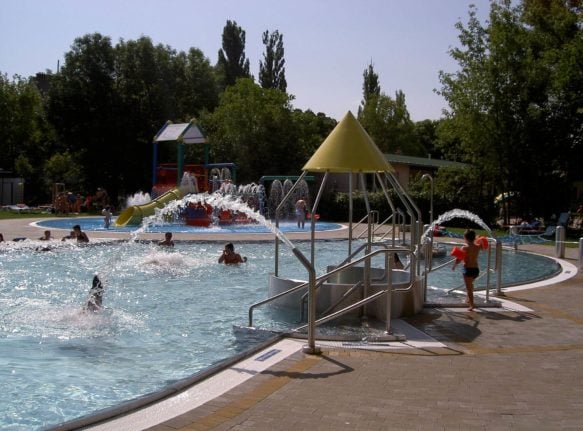Austria is a beautiful Alpine state, famous for its majestic mountains, stunning lakes, picture perfect meadows and nature in all its abundance. However, even the Garden of Eden had a resident snake.
There are more than a few dangers you should be aware of before strapping on your hiking boots and heading into the great outdoors.
You could be chased by a boar, bitten by a tick, accidentally eat something poisonous or get an itchy rash from a caterpillar every time you step outside.
Here’s what you need to know.
Wild boar
The British ambassador to Austria was chased by a rampaging wild boar a few years ago while out walking in the Vienna woods in the city’s Lainzer Tiergarten.
Writing in his blog, Leigh Turner said he suddenly found himself face-to-face with a group of “four or five hulking adults and countless piglets”.
He tried to walk away quietly but then said he heard a noise behind him like a “galloping horse” and turned to see a “massive wild boar”, head down, charging straight at him.
Mr Turner tried to climb a pile of tree trunks to escape, and hurt his hand.
It could have been worse, a man in Berlin had his laptop stolen by a wild boar last year and made headlines around the world while chasing after it naked.
Summer of 2022 I feel we’ll all be naked man chasing wild boar. pic.twitter.com/88SIXH1R7S
— Matthew Highton (@MattHighton) January 5, 2021
Ticks
Tiny little ticks may be among the most dangerous animals you will encounter living in Austria. It’s important to be vaccinated against tick borne encephalitis if you live here, especially if you enjoy hiking and being in the outdoors.
According to media reports a record of 215 illnesses and three deaths from this disease was set in 2020.
Lyme disease is also a risk factor in much of the country. A recent study found a third of the country’s ticks are infected with borrelia, the bacteria which causes Lyme disease.
Lyme disease is easily treated if caught soon after infection, but becomes more serious if left untreated. Time to stock up on tick repellent and invest in some long trousers before heading out into the wilderness.
Another thing to bear in mind is you should wait two weeks to be given the TBE vaccine if you have had a coronavirus vaccination, according to Austria’s National Vaccination Committee
READ MORE: A promising treatment for Lyme disease
Caterpillars
Many of Vienna’s parks had to be closed last year due to an infestation of Eichenprozessionsspinner, or oak processionary moth caterpillars.
The caterpillars are covered in tiny hairs which can break off and cause itching, skin rashes and breathing difficulties.
You can find out more here (German language link), or here.
Wild Garlic
A popular pastime in Austria is going into the woods to hunt for wild garlic (Barlauch), which is used in recipes for soup, pesto, bread and even wild garlic chicken Kiev.
However, what some people may not realise is that wild garlic is very similar in appearance to Lily of the Valley (Maiglockchen), which is poisonous.
The smell should help you differentiate between the two, otherwise this helpful guide (German) or this one (English) will steer you in the right direction.
Mushrooms
Foraging for mushrooms is also a popular pastime in almost every province of Austria, as they grow in abundance everywhere. Particularly prized are Eierschwammerl (Chanterelles) or Steinpilze (Ceps or Porcini). However, it’s important not to pick the wrong kind. Of the 8,800 known species of mushrooms in Austria, which incidentally do not belong to either the kingdom of animals or plants, there are only 100 species which are edible.
You can read more about the code of conduct for mushroom pickers here or a guide on how to do it properly here. And remember the first rule of foraging: When in doubt, leave it out.
Wolves
Wolves have returned to Austria in recent years. In 2016 the first Austrian wolf pack was established in Allentsteig, a military training ground in Lower Austria. The Wilderness Society reports a second one has been found at the Austrian-Czech border near Karlstift.
According to the BBC Earth website, while hundreds of years ago wolves in Europe roamed around attacking child shepherds, as rabies has been largely eliminated and children are no longer put to work looking after sheep, they pose far less risk to humans today.
Bears
Brown bears can also be found in Austria. An EU report found the possibility of accidents involving bears “cannot be eliminated” though they are very rare.
Read more: Italian bears return to Austria’s woods in force
According to the report there are bear populations in the Northern Limestone Alps, descended from three bears released by the WWF in the early 1990s and in the Karawanken along the border of Carinthia and Slovenia.
Read more: Farmer attacked by a bear in Salzburg

Lynx
There are now a handful of lynx (Luchs) living in Austria, according to the Wilderness Society. They were reintroduced from Switzerland in 2011 after dying out 100 years ago.
There are differing views on how dangerous lynx are to humans. While the Lynx society says they pose no danger to humans, in Britain, the National Farmers Union warned they might attack members of the public if re-introduced to the wild, according to a report in the English Telegraph newspaper.
The lynx is a large cat with fluffy ears and a pointy beard, sometimes called the wizard of the forest. Lynx are rarely seen, and live in wild, mountainous forests away from humans, such as in the remote forests of the border regions of Styria, Upper and Lower Austria.
A new Lynx long-distance hiking trail through this area was recently created from Reichraming in Upper Austria via Styria to Lunz am See in the Mostviertel in Lower Austria.
German vocabulary
Ticks – Zecken
Tick bourne encephalitis – Zeckenenzephalitis / Frühsommermeningoenzephalitis (FSME)
Lyme disease – Die Lyme-Borreliose
Wild Boar – Wildschweine
Lynx – Luchs
Bear – Bär
Wolf – Wolf



 Please whitelist us to continue reading.
Please whitelist us to continue reading.
Member comments